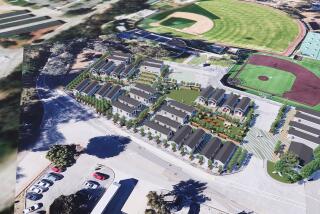Laguna Niguel, Builder End Their Land Dispute : Settlement: City will let building resume on disputed acreage. Taylor Woodrow will drop $25-million suit.
LAGUNA NIGUEL — Abandoning an 18-month-old court fight sparked by the discovery that homes were built on land once reserved for public open space, Laguna Niguel has agreed to allow the developer to continue building on the disputed acreage.
In return, the company has agreed to drop the $25-million damage suit it filed against Laguna Niguel after the city voted to impose a moratorium on the project in 1990.
City Atty. Terry E. Dixon said Wednesday that a city investigation showed that the developer, Taylor Woodrow Homes California Ltd., did nothing wrong.
Dixon and city officials said that if anyone is to blame for the controversy it is the Orange County planning officials who unwittingly approved changes in the land-use plan long before the dispute erupted.
It was unfortunate, Dixon said, that the whole matter got out of hand after some county planning staff members “shot their mouths off” as the district attorney’s office was looking into the question.
The city’s conclusion was in sharp contrast with a harshly worded Orange County Grand Jury report in 1991 that said 96 acres of open space were signed away in 1988 by inattentive, misinformed public officials and turned over to a development company that “acted on the fringe of the law” in getting control of the disputed land and showed “disdain for the system.”
But the city adopted a more conciliatory tone Wednesday in announcing settlement of its dispute with Taylor Woodrow Homes.
“We’re all glad that this has come to an end,” Dixon said, describing the sentiments of the four City Council members who voted to approve the settlement. Councilman James F. Krembas abstained from voting on the settlement because of his involvement in the land transfer when he was a member of the Community Services District formed before Laguna Niguel became a city.
“The dispute has done nothing for this city,” Dixon said, adding, “It’s been divisive and it is time to move on.”
Gordon Tippell, chairman of Taylor Woodrow Homes, said his firm was similarly “anxious to put this behind us and move forward. Obviously, this lengthy investigative process has been tremendously disruptive and costly.”
The battle between the city, the county and the developer had its roots in a Feb. 12, 1988, land transaction signed by Krembas, a services district vice president, while President Patricia C. Bates was out of town. Bates and other members of the district board later said they were stunned to learn of the land transaction.
But Dixon insisted Wednesday that the actions taken at the Community Services District were “perfunctory,” since the county’s earlier approval of land-use changes made the later actions moot.
The property had originally been deeded to the county in 1985, when another developer owned the 520 acres of land that ultimately became the Marina Hills subdivision.
When Taylor Woodrow Homes purchased the undeveloped land later that year, company officials say they sought and received approval from the county Planning Commission to build on part of the open space. In exchange, they promised to devote other land for parks and recreational facilities when building Marina Hills, company officials said.
Three years later, the property was signed over by Krembas to Taylor Woodrow Homes, which a few months later hired Krembas’ wife, Jeanette, to head a newly created sales office.
Krembas, who denied any wrongdoing and said his wife’s hiring was entirely unrelated, said Wednesday that the city’s investigation confirmed his earlier contention that he had no choice but to sign the quitclaim deed.
The controversy “caused me and my family no end of stress and defamed my character,” Krembas said. “But how does one vindicate the fact that you have had 18 months of stress, financial hardships and everything else that came with this mess?”
City Manager Tim Casey said Laguna Niguel spent $50,000 to $100,000 in legal fees and to investigate the land transfer. Taylor Woodrow officials said the affair cost the company $300,000 in legal fees alone, plus untold sums in goodwill.
The 1991 grand jury report made 14 recommendations to tighten the county’s oversight of land transfers and its review of development maps. In addition to criticizing current and former Laguna Niguel officials and Taylor Woodrow Homes, the grand jury attacked county planning officials for failing to notice that the company’s plan omitted an earlier dedication of parkland and replaced it with plans for homes.
It also said the Community Services District manager and counsel gave the district board incomplete and misleading information.
Without using names, Dixon acknowledged that the confusion could have been avoided if the general manager and attorney for the district had presented all the information to the board.
Dixon was referring to James S. Mocalis and James S. Okazaki, who were then the manager and attorney for the Community Services District. Both men voluntarily appeared before the grand jury investigating the land matter. No criminal charges ever came out of the hearing.
“You would think that they would have known better,” Dixon said. “These were not inexperienced public managers. That was just not typical procedure.”
City Manager Casey agreed:
“Some people say that the time our staff now spends writing a report to the council about National Girls Scouts Week is more than the entire time spent on the (land transfer) report that went to the Community Services District.”
Mocalis described that accusation as “a bunch of malarkey.”
“We acted competently and professionally,” Mocalis said. “The board had all the information” when it voted.
Dixon said city officials waited for the grand jury to conclude its investigation in hopes that it would help them answer some questions raised by the public. It did not, he said, adding that the report took swipes at the Community Services District.
But Deputy Dist. Atty. Wallace J. Wade, who oversaw the investigation, defended the grand jury’s report.
City Councilman Paul M. Christiansen said that to continue the legal action would have cost the city hundreds of thousands of dollars in legal expenses.
The City Council based its decision to drop the matter on an in-house investigation conducted by Dixon and city staff members with the help of some outside consultants who looked into the county’s approval of the Marina Hills plan.
That report concluded:
* When the county approved the Marina Hills plan, it was fully aware of the 96 acres of dedicated open space offered by the previous owner.
* The Taylor Woodrow plan provides about as much total open space as did the previous plan. In addition, the Marina Hills plan includes fully improved public parks and baseball fields, soccer fields, basketball courts and restrooms within the open space. There were no additional homes in the new plan and no loss of open space, and an actual increase in public facilities.
* Taylor Woodrow Homes followed all required county procedures in the approval and development of Marina Hills.
* Neither the city of Laguna Niguel nor the Community Services District had the authority to change the Marina Hills Plan, which was approved by the county before Laguna Niguel became a city.
* The county’s approval of the Marina Hills plan superseded and entirely replaced the earlier plan and legally nullified the previous offer to dedicate the 96 acres of open space.
Parkland Dispute: A Chronology
November, 1985: Orange County Planning Commission approves a development plan submitted by Taylor Woodrow Homes California Ltd., which bought 520 acres in Laguna Niguel from another developer. Maps accompanying the new plan show housing development on a portion of land that had previously been designated as open space.
Jan. 20, 1988: James S. Mocalis, general manager of the Laguna Niguel Community Services District, recommends that the district board approve some changes to a planned housing development on the acreage. Mocalis explains that Taylor Woodrow will swap eight scenic acres of open space for three acres of less-desirable land. There is no discussion of signing away 96 acres of land. The board approves the changes.
January, 1988: Taylor Woodrow deeds eight acres to the city of Laguna Niguel. The deed is sent to Mocalis but is not filed with the recorder.
February, 1988: Laguna Niguel CSD Vice President James F. Krembas, acting for the district board but without having consulted the other members, deeds 96 acres of open space along Niguel Road to Taylor Woodrow. The quitclaim releases all public interest in the land, estimated to be worth $70 million.
May, 1988: Krembas’ wife, Jeanette, is hired by Taylor Woodrow to manage one of its sales offices.
July, 1990: Laguna Niguel officials learn from county engineers that they unwittingly gave up 96 acres instead of three. Additionally, there is no record of the eight scenic acres that had been deeded to the city by the developer in the January, 1988, transaction signed by Mocalis.
July, 1990: When it is disclosed that the district attorney is investigating the land transaction, the Laguna Niguel City Council votes 4 to 0 to impose a building moratorium on Taylor Woodrow.
October, 1990: Taylor Woodrow files $25-million damage suit against Laguna Niguel for lost earnings and goodwill. In a related action, the company also files a suit to force the city to lift the building moratorium, which halted the completion of about 65 homes.
January, 1991: Laguna Niguel files a lawsuit against Taylor Woodrow alleging that the developer led Krembas to believe that he was giving the company only three acres north of the Salt Creek Corridor Regional Park, not 96 acres. The lawsuit seeks to overturn the 1988 transaction and reimburse the public for the loss of open space.
June, 1991: At the conclusion of its investigation, the Orange County Grand Jury accuses Laguna Niguel officials of mishandling the land transaction and alleges that Taylor Woodrow “acted on the fringe of the law” to get the deal done.
July, 1991: The Superior Court rules that because Laguna Niguel failed to hold a fact-finding hearing before imposing the building moratorium in July, 1990, the moratorium was illegally imposed. No criminal charges are filed against any of the parties involved.
August, 1991: Laguna Niguel officials decide to appeal the court decision that invalidated the building moratorium; they also direct their attorneys to review issues not addressed by the grand jury.
March, 1992: Taylor Woodrow and Laguna Niguel reach a settlement allowing the builder to continue constructing homes in exchange for the company’s dropping its $25-million suit against the city. The city also agrees to drop its appeal of the earlier court decision invalidating the moratorium.
Source: Los Angeles Times files
Compiled by April Jackson / Los Angeles Times
Building to Resume on Disputed Land
Laguna Niguel has agreed to allow developer Taylor Woodrow to build more homes on what had originally been designated as open space, ending an 18-month dispute. The land was originally dedicated to the county by another developer, Avco.
Settlement Highlights
* The city will dismiss its appeal on a building moratorium.
* Taylor Woodrow will withdraw its $25 million damage claim against the city.
* New building permit conditions will revert to those in force when the moratorium was enacted in 1990.
More to Read
Sign up for Essential California
The most important California stories and recommendations in your inbox every morning.
You may occasionally receive promotional content from the Los Angeles Times.










